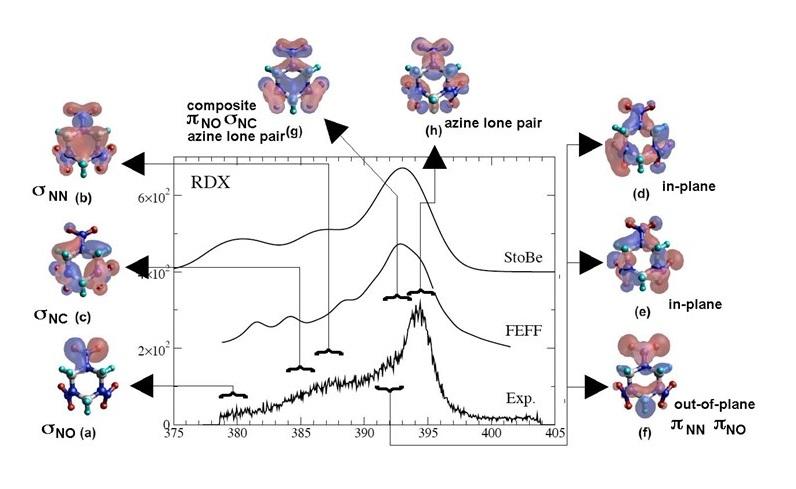X-ray Spectroscopy and Electronic Structure of Solids
X-ray absorption and x-ray emission spectra can be used to identify specific elements in a chemical compound. X-ray transitions that involve the valence bands of these compounds contain a great deal of information about the structure that contributes to their chemical bonding and dynamical behavior. We conduct high resolution experiments at synchrotron light sources optimized for the creation of tunable soft x-rays. Emission spectra are obtained at high resolution using grating spectrometers. Theoretical calculations carried out using state-of-the-art computation on our own cluster reveal the complex physical effects necessary to explain this behavior. Very slight changes in energy can result in large changes of x-ray emission, due to dynamical screening effects. One goal of the project is to understand these effects well enough to compute accurate spectra in advance for purposes of chemical identification or forensics. High resolution x-ray emission spectra provide information comparable to x-ray photoemission spectroscopy, without the need for ultra-high vacuum. The ultimate aim of the project is to observe processes such as catalysis or biochemical reactions under realistic conditions as they happen.

Facilities
Advanced Light Source (LBL), BESSY II Light Source (Berlin, Germany), computational cluster
Customers/Contributors/ Collaborators
Dr. Burkhard Beckhoff (PTB, Berlin, Germany)
Major Accomplishments
Analysis of x-ray emission and absorption spectra of nitrogen, carbon, and sulfur, including the spectra from explosives, proteins, and crystalline insulators. Identification of “disappearing” spectroscopic features due to many-body electron interactions. The effect of thermal disorder on excitonic and band features in absorption spectra. Effect of zero-point quantum motion of lattice atoms on the distortion of x-ray absorption spectra.
Related NIST Projects
High resolution x-ray microcalorimeter detector
Related Publications
“X-ray Emission Spectroscopy of Nitrogen-rich Compounds,” Fernando D. Vila, Terrence Jach, W. T. Elam, John J. Rehr, and J. D. Denlinger, J. Phys. Chem. A 115, 3243 (2011).
“Origins of extreme broadening mechanisms in near-edge x-ray spectra of nitrogen compounds”, John Vinson, Terrence Jach, W. T. Elam, and J. D. Denlinger, Phys. Rev. B 90, 205207 (2014).
“Quasiparticle Lifetime Broadening in Resonant X-ray Scattering of NH4NO3”, John Vinson, Terrence Jach, Matthias Müller, Rainer Unterumsberger, and Berkhard Beckhoff, Phys. Rev. B 94, 035163 (2016).
“Resonant X-ray Emission of Hexagonal Boron Nitride”, John Vinson, Terrence Jach, Matthias Müller, Rainer Unterumsberger, and Berkhard Beckhoff, Phys. Rev. B 96, 205116 (2017).
“Resonant X-ray Emission and Valence-band Lifetime Broadening in LiNO3”, John Vinson, Terrence Jach, Matthias Müller, Rainer Unterumsberger, and Burkhard Beckhoff, Phys. Rev. B 100, 085143 (2019).

